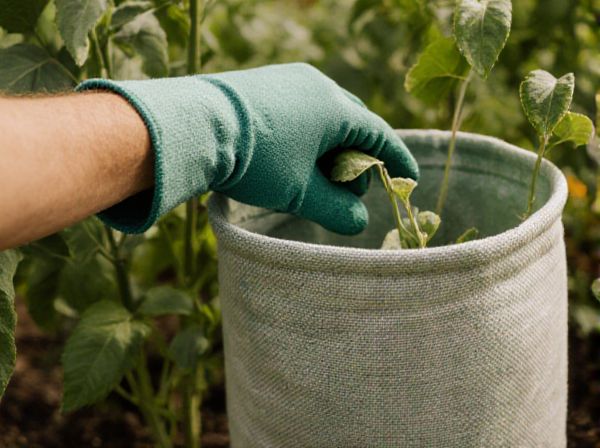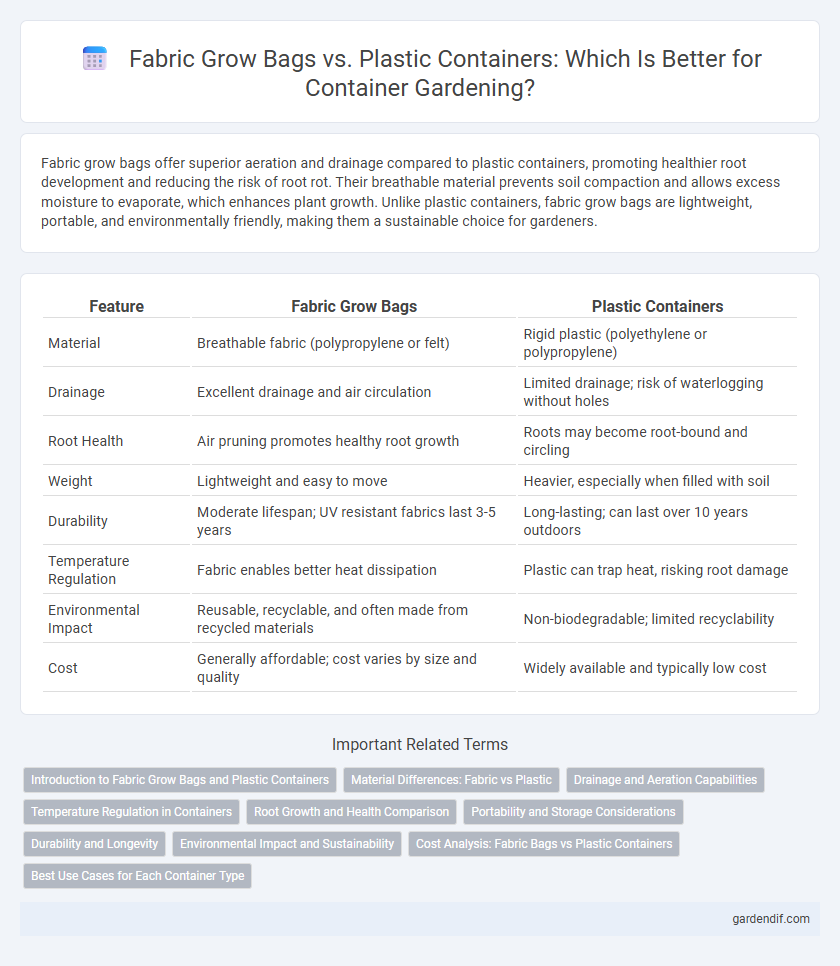
Fabric grow bags vs plastic containers Illustration
Fabric grow bags offer superior aeration and drainage compared to plastic containers, promoting healthier root development and reducing the risk of root rot. Their breathable material prevents soil compaction and allows excess moisture to evaporate, which enhances plant growth. Unlike plastic containers, fabric grow bags are lightweight, portable, and environmentally friendly, making them a sustainable choice for gardeners.
Table of Comparison
| Feature | Fabric Grow Bags | Plastic Containers |
|---|---|---|
| Material | Breathable fabric (polypropylene or felt) | Rigid plastic (polyethylene or polypropylene) |
| Drainage | Excellent drainage and air circulation | Limited drainage; risk of waterlogging without holes |
| Root Health | Air pruning promotes healthy root growth | Roots may become root-bound and circling |
| Weight | Lightweight and easy to move | Heavier, especially when filled with soil |
| Durability | Moderate lifespan; UV resistant fabrics last 3-5 years | Long-lasting; can last over 10 years outdoors |
| Temperature Regulation | Fabric enables better heat dissipation | Plastic can trap heat, risking root damage |
| Environmental Impact | Reusable, recyclable, and often made from recycled materials | Non-biodegradable; limited recyclability |
| Cost | Generally affordable; cost varies by size and quality | Widely available and typically low cost |
Introduction to Fabric Grow Bags and Plastic Containers
Fabric grow bags offer superior aeration and drainage compared to plastic containers, promoting healthier root systems and reducing the risk of root rot in container gardening. Made from breathable, non-woven materials, fabric grow bags prevent soil compaction and enhance oxygen flow to plant roots, supporting vigorous growth. In contrast, plastic containers provide a lightweight, affordable, and reusable option but often suffer from poor drainage and limited airflow, which can lead to waterlogging and root health issues.
Material Differences: Fabric vs Plastic
Fabric grow bags are made from breathable, non-woven polypropylene, allowing superior aeration and drainage compared to plastic containers, which are typically composed of rigid polyethylene or polypropylene. The porous nature of fabric bags promotes healthier root growth by air pruning roots and preventing circling, while plastic containers may retain excess moisture and limit oxygen flow. Fabric's flexibility also enables easy storage and transportation, contrasting with the rigid, less adaptable structure of plastic containers.
Drainage and Aeration Capabilities
Fabric grow bags offer superior drainage and aeration compared to plastic containers, preventing waterlogging and promoting healthy root oxygenation. The breathable material allows excess moisture to evaporate, reducing root rot risks and encouraging robust root systems. In contrast, plastic containers often retain water, limiting airflow and potentially leading to anaerobic soil conditions.
Temperature Regulation in Containers
Fabric grow bags offer superior temperature regulation compared to plastic containers by allowing better air circulation and promoting root aeration, which prevents overheating. The breathable material in fabric bags dissipates heat more effectively, maintaining cooler root zones during hot weather. Plastic containers tend to trap heat and moisture, increasing the risk of root stress and reduced plant growth.
Root Growth and Health Comparison
Fabric grow bags promote superior root growth by allowing air pruning, which prevents root circling and encourages a healthier root system compared to plastic containers that often restrict roots. The breathable fabric material enhances oxygen flow and drainage, reducing the risk of root rot and improving overall soil aeration. Plastic containers, while sturdy, can trap excess moisture and heat, potentially leading to poorer root health and stunted plant development.
Portability and Storage Considerations
Fabric grow bags offer superior portability due to their lightweight, flexible material that can be easily folded and transported compared to rigid plastic containers. When considering storage, fabric bags require minimal space as they collapse flat, making them ideal for compact environments or seasonal gardening. Plastic containers, while durable, often demand more storage room and are bulkier to move, limiting their convenience for gardeners who need mobility or space-saving solutions.
Durability and Longevity
Fabric grow bags offer superior air permeability and root aeration compared to plastic containers, reducing root circling and promoting healthier plant growth. While plastic containers are generally more resistant to weathering and can last several years, they may become brittle and crack under prolonged UV exposure. Fabric grow bags typically last 3 to 5 seasons depending on material quality and environmental conditions, but their flexibility and improved drainage significantly enhance plant health over time.
Environmental Impact and Sustainability
Fabric grow bags significantly reduce environmental impact by utilizing breathable, reusable materials that minimize plastic waste and enhance root aeration, promoting healthier plant growth. Unlike traditional plastic containers, fabric bags are often made from recycled or biodegradable fabrics, lowering carbon footprints and reducing landfill accumulation. Their durability and ability to decompose naturally make fabric grow bags a sustainable alternative that supports eco-friendly gardening practices.
Cost Analysis: Fabric Bags vs Plastic Containers
Fabric grow bags generally have a higher upfront cost compared to plastic containers but offer better long-term value due to enhanced root aeration and reduced plant stress, leading to healthier growth and potentially higher yields. Plastic containers are more affordable initially and widely available, but they may lead to higher replacement costs and environmental disposal fees over time. Considering lifecycle costs and environmental impact, fabric grow bags present a cost-effective solution for sustainable container gardening.
Best Use Cases for Each Container Type
Fabric grow bags offer superior aeration and drainage, making them ideal for root vegetables, herbs, and plants requiring excellent soil health and airflow. Plastic containers retain moisture better and provide durability, which suits water-loving plants, long-term use, and environments where weight and space efficiency are crucial. Choosing fabric grow bags benefits seasonal gardening and transplanting, while plastic containers excel in hydroponics and permanent plant displays.
Fabric grow bags vs plastic containers Infographic

 gardendif.com
gardendif.com